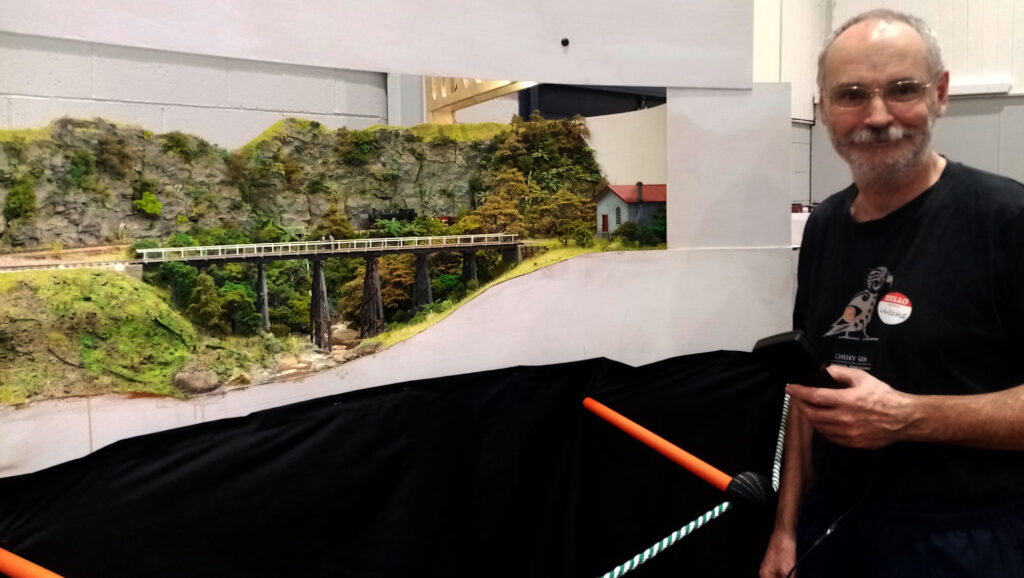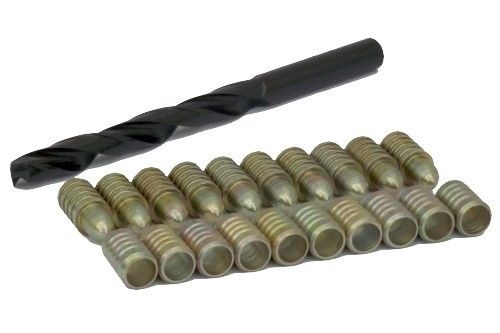The 2023 Christchurch show, this last weekend, was my first as an exhibitor in a long time and Rewanui’s first outing. Deadlines are great for focussing effort, and a great deal was accomplished in the lead up that would otherwise have languished in the ‘too hard’ basket. Rewanui is a work in progress but I think we managed to present an interesting display. We survived, but what did we learn?

Yours truly in the driver’s seat. (Bryan Stevenson photo)
Engagement
The layout is exhibited so that the track is close to eye level for an adult of modest stature. Older children and most adults get a reasonable look, but the disabled, young children and the seriously vertically challenged do struggle. Providing a step stool meant that nearly everyone could enjoy it. Parents probably cursed me when their offspring demanded to be carried for a view, but in reality under 8s are not my target audience.
While not entirely finished in terms of presentation we have taken a theatrical approach with constrained views, a pelmet with concealed lighting and so on. This year there was a short video showing with period film, stills and a few descriptive slides.
One advantage to the higher than average baseboards is that the natural tendency for people to lean and touch is much reduced. My barriers are currently 500mm or so from the baseboard face, but I may reduce that a bit in future to allow more intensive peering.
Did people ‘get it’? On the whole and without help, I think not. NZ shows attract a general audience rather than committed railfans/modellers so many have little idea what they are seeing. Rewanui is a model set in a place and time (1940) that is relatively inaccessible for most in 2023 urban Christchurch. Without providing context as to the real place and what has been done to create the model most of the audience were underwhelmed. People with some familiarity for the area, period or the model certainly did understand what we are trying to do. Actively engaging with the audience and explaining what was going on (with reference to the video presentation) hugely increased the understanding and enthusiasm of the viewers. The layout is front operated, and we fell into a routine where generally Haydn would run the trains and I would talk to people. The audience clearly appreciated the dialogue with only one or two exceptions. We certainly had a lot of feedback, almost all of it positive.
The lesson for Rewanui (and possibly other layouts) is that one should not assume the layout is accessible of itself. There may need to be additional interpretive material to provide audience context. We will certainly be making the prototype video part of the long term display and be thinking about other approaches.
Track movement
It’s been observed many times that apparently stable track will distort inconveniently when exhibited. I was more than half expecting it, and the fiddle yard suffered from it. Fortunately it was easily fixed in the absence of scenery. Why does this happen? It’s tempting to blame rail expansion in a hot hall, but this does not fit the facts. Firstly metal does not expand that much in the temperature changes we are talking and secondly if this were the culprit we would expect it to happen relatively quickly (minutes). So if it is not the rail it can only be the baseboards, and this is more likely. Wood and (in my case) MDF move significantly with changes in humidity. A hot dry hall is quite likely to cause baseboard shrinkage over hours or days which is the timeframe over which track distortion occurs. It is easy to fix, just lay rail with gaps to allow for the effect. Constructing the baseboards from plywood would probably resolve it as well.
Attrition
For the last 20 years or so I’ve been building models with no ready means and little enthusiasm for actually running them. This means I have models that typically looked good in photos when I ‘finished’ them, but may have been short on operational perfection. We only noticed W238 was lacking a coupling hook, when we backed down on to the first train.
Over the 20 years my standards for couplers, sources for wheels and similar variables have all changed, often more than once. There’s been some innovation too, the longevity of which is being discovered as time goes by. Add to that that storage has not always been ideal and some models have degraded a bit. So when I came to assemble stock for the show (Friday afternoon), I uncovered an extensive rotten row, and only a scant few items ready for service. Quite a few issues were relatively minor and quickly rectified. In reality, there was plenty of stock for the available rail, but the mental picture of my active roster took a bit of a hammering.
It wasn’t really a surprise that my stock collection will need some maintenance and upgrading to consistent standards before Rewanui can be run properly.
Loco design
In a recent post I outlined thoughts on locomotive chassis design. An exhibition was a good chance to test the merits of those philosophies.
We embarked on the weekend with one suitable locomotive. W238 was completed some time ago and tucked away in a box. I pulled it out the day before and discovered it was not as entirely finished as I remembered, but was presentable. It is built from my W kit, has all the refinements described in the earlier blog post and runs on scale wheels. Nevertheless this is a loco that has had no running other than up and down a 1m piece of flex track when the DCC chip was installed. I was a bit anxious.
I didn’t get around to cleaning the track, although in the weeks leading up to the show I had scraped the paint from the rail tops and given it a bit of a buff. I didn’t get a chance to clean the steel tires either which had been sitting around for a very long time (years). So how did it work?
- On the Friday night night set up session we did get a few truck derailments at the transition to the sector plate. This was completely solved by providing a bit more spring tension for more downforce on the trucks (and a bit of attention to the rail). Literally a few minute’s work.
- The loco ran for the entire show. It shuttled back and forth over 3-4m of rail. During that time it never stalled, hesitated or had a single pickup issue. All the running was quite slow. We had a short run and the ruling speed limit at Rewanui was 10mph. Half the running was propelling the train as well. While the track is pretty good, the transitions to the sector plate in the fiddle yard are not perfect, so it did have the occasional lump to negotiate. One leg of the turnout frog was dead too – so the loco was negotiating 20mm or more of rail without power every cycle.
- We never did clean the track, nor any of the wheels on loco or stock.
In short, loco performance was impeccable. Lucky? Probably. But without doubt it shows that good chassis design will allow locomotives to reliably negotiate filthy, dead and rough spots. Certainly you want to avoid such things, but that is not always possible, especially under exhibition conditions.
Testing
Essential (he says, having completely neglected to do so in a number of key areas). The bits that were actually tested were pretty trouble free (a lot of the ones not tested as well, fortunately). One thing I didn’t test caught us out majorly. The main line is fitted with centre rail and stock has been built with this in mind. Locos have cutaway cowcatchers per the prototype and gearbox design has allowed clearance. What I failed to consider was side play on unprototypically tight curves (1300mm radius). I did get a bit of luck though. W238 in it’s slightly unfinished state has a somewhat nose-down attitude as I hadn’t adjusted the chassis levelling screw. This raised the rear cowcatcher enough to clear the centre rail. This rather awful fudge was not apparent from normal viewing angles so we dodged a bullet there. It does mean I need to rethink and likely relay the main line track.
Baseboard assembly and alignment
Another thing that went well was the set up/take down of the layout. Quick and low stress.
A number of factors contributed to that:
- The boards are square, relatively light and robust, as is the support structure.
- Boards are aligned using dowels similar to those in the manufacturer’s image below. These ensure repeatable alignment time after time. Two dowels are placed for each joint at a suitable spot towards and to either side of the roadbed. Highly recommended.
- ALL fixings are achieved using M8 dome head cap screws into T nuts or threaded inserts captured in the structure. As such, once started by hand, they can be driven using a hex driver in a battery drill. The whole thing goes very fast.
- The layout sits on threaded feet with soft surface to protect the floor and allow adjustment.
- All hardware was purchased from AliExpress for a tiny fraction of the cost of obtaining them locally.
- The track at baseboard edges is laid continuously and soldered securely to PCB strips epoxied to the baseboard. It is then cut with a slitting disc along the line of the join. On assembly it just lines up and works without any additional steps.
- Electrically the layout is DCC in a single block, so there are only 2 wires to carry between baseboards. At present this is done via screw terminals. This might get a little more complex when all the turnouts and uncouplers are in, but hopefully not by much.

Typical dowels. Mine are 10mm driven into 9.5mm holes in the baseboard ends.
Not quite so smart is that I did not really plan a location for clamping bolts. As a result these are placed wherever viable, which is not always that accessible. Fortunately the layout is high and those bolts that are awkward can still be reached with a ratchet handle with minimal inconvenience.
Overall
So a fun weekend, somewhat different to my usual show routine of just cruising the layouts and catching up with people. We had very few problems, certainly fewer than we feared, and those were resolved quickly without any great stress.
The layout has a lot of features that are new to me, and unusual or unique in the crop of exhibition layouts locally. Most of this innovation worked well. While there is the odd thing we can improve, none of that should be particularly dramatic or difficult (though I’m not looking forward to lifting the main line).

2 comments